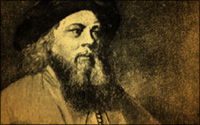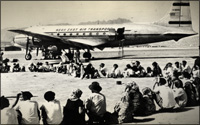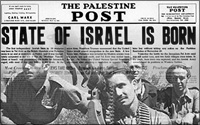 The spiritual vacuum created by false messiahs, poverty and persecution in Eastern Europe was filled by the Chassidic Movement, founded by the Baal Shem Tov.
The spiritual vacuum created by false messiahs, poverty and persecution in Eastern Europe was filled by the Chassidic Movement, founded by the Baal Shem Tov.
The 18th century brought with it great, revolutionary changes in the world at large and the Jewish world in particular. The century saw the American Revolution, the French Revolution, the spirit of Enlightenment, the Age of Reason – all of which ushered in the modern era.
In the Jewish world, there also came about revolutions. In Western Europe, Jews experienced the coming of Reform, assimilation and the hope that through emancipation they would be truly accepted among the nations. In Eastern Europe, the revolution took a completely different turn. It was the rise of the movement that we call Chassidus.
This was a radically different revolution than what took place among Jews in Western Europe. In the West, the revolution aimed to make Jews less Jewish. In the East, it was to become more Jewish. In the West, the revolution was designed to allow the Jew to take a strong, active and contributing role in the general society. In the East, the revolution sought to separate the Jew from the society in which he lived, and to build a wall – if not physically, then spiritually; a world all unto his own; a value system that had nothing to do with his Polish-Christian neighbors.
This revolution was no less radical than the revolution in Western Europe. However, the main difference in the West was that it went outside the parameters of Jewish law, the accepted framework that the Jewish people had functioned under for thousands of years. It redefined not just Jews, but Judaism. The parameters of the revolution in Eastern Europe, by and large, were within the boundaries of Jewish law. It did not come so much redefine Judaism as much as to change the nuance and emphasis.
Eventually, the Chassidic revolution would be so successful that the majority of religious Jews in Eastern Europe would subscribe to its viewpoint and way of life. It is an example of the revolution becoming the establishment.
Master of the Good Name
In 1698, a man was born in the city of Okup, which was in the province of Podolia of Polish Russia near the Carpathian Mountains. He was given the name Israel. He later became known as the Baal Shem Tov, the “Master of the Good Name.” There were others that had that name, but after him no one was called by that.
His personal life is shrouded legend and mystery. His father was very old when he was born. During his youth he was a dreamer. He would go out in the fields for long periods and hear the conversation of birds and animals. He was not known for his scholarship in school. In fact, at the age of 12 he was already working, taking children to school and then home again.
He was apparently orphaned at a very early age. According to legend, inside of him was this great and unquenchable soul who secretly mastered the entire Torah. He was not only a master of the revealed Torah, but a master of the hidden Torah, i.e. Kabbalah. Like a true mystic, he hid his greatness for many years. Only later did he go public and develop a following.
Roots
When he turned 36, in 1734, the Baal Shem Tov went public. He quickly gained the reputation as a genuine miracle worker and drew a following. It was said that he traveled in the company of angels, healed the sick, opened the eyes of the blind, etc. – miracles attributed in the Jewish tradition only to the prophets of the Bible.
One of the reasons his movement would engender such strong opposition was because of the claims made on its behalf. No one had claimed that Maimonides could cure the blind or that Rashi could fly in a coach from Troyes to Paris. In the eyes of some Jews, the claims said about the Baal Shem Tov undermined the movement. Nevertheless, his reputation spread far and wide among the masses.
He took up residence in a town in the Podolia region called Medzhybizh (Mezhbitz). It is the founding village of the Chassidic Movement. Later the movement would spread to the big cities, but originally it took root in small towns and villages. Most of the famous Chassidic dynasties would be named after these small towns where their founders resided.
Some of the Basic Ideas
The Baal Shem Tov attracted a number of very great and charismatic people. They were the ones, even more than he, who spread the movement. Each emphasized nuances of authentic Jewish tradition in fresh ways and thereby drew their own followers. Nevertheless, there were certain basic concepts that became characteristic of the movement as a whole.
First, it brought God down to Earth, so to speak, in a way that had not been done for centuries. This is one of the reasons it became so popular — and was so criticized. It came dangerously close to pantheism. In its zeal to make God real, Chassidism cut all of the barriers, so to speak, between the Creator and the created. Since it was dealing with a relatively unsophisticated and unlettered element, it had to do it in an almost extreme fashion. The removal of the barriers made God folksy.
On the positive side, it made the Jew feel that God had a relationship to him, that everything he did was important to God and that God was approachable on every level. Therefore, we find in Chassidic thought that there is no small thing regarding God. If your cow did not give enough milk it was God’s business also. You could interrupt your prayers and tell Him, in Yiddish, “God, on top of all my other problems, my cow is not giving milk anymore. Please help.” Some saw this as a regression to a primitive form of religion. On the other hand, it made for deeply religious people whose entire lives were God-oriented.
Another major emphasis in the Chassidic Movement was prayer. From its leaders’ perspective, it had become a neglected art – especially among the common people. Prayer was the gate to heaven.
Their take on prayer was not new, but their emphasis brought it almost to an extreme. They stressed the proper frame of mind and heart that the person had to have while praying so much that even matters of Jewish law were sometimes neglected. For instance, they were notoriously not punctilious in praying at the set times for prayer. They, in effect, said what good it is to pray on time if one cannot do so properly. If one has a choice of praying on time without any feeling or praying with feeling but past time, God prefers the latter. This likewise opened up a strong bone of contention with their opponents.
One result of the emphasis on prayer is that the study of Torah to a certain extent became diminished. The Talmud states that prayer is not a great as study. And to the great scholars, the study of Torah was supreme, which is not to say that they neglected or undervalued prayer. They did not. But they saw it as the highest mode of religious expression.
The Chassidic Movement challenged that or deflected that. They did not say that one should not study Torah. They did not even disagree that Torah was the centerpiece of Jewish life. However, by putting the nuance on God and prayer they changed it, so that even someone who was not at all learned felt that he was able to be equal with others who had great knowledge in his service of God.
The Baal Shem told people to be very joyful and have an optimistic frame of mind. That was based on the idea that a person is in constant contact with God. Therefore, as the Talmud says, the Divine Presence does not dwell on someone who is morose, but only on someone who rejoices in his service to God. Everything had to be done joyfully.
Finally, the movement instituted the idea of the Tzaddik – the Righteous Jew – and the center around which the service of God revolved. As a generator is to a power station, so too is the Tzaddik (or Rebbe) to his Chassidim, his followers. If one was plugged into him, so to speak, his holiness reached one as well. It became part and parcel of the follower as well.
Eventually, in Chassidism the Rebbe became almost superhuman. They saw him not only terms of someone who could influence heaven, but someone who had a great say in what was going on there. They ascribed supernatural powers to him. It became customary among Chassidim to tell stories and legends about their leaders, to invest them with the aura of inspired and all-knowing miracle workers.
Passing the Mantle
The Baal Shem Tov died in 1760. Because his movement then was still in its revolutionary phase, the mantle of leadership did not pass directly to his descendants. It did not pass so much through genetics as it did through merit.
Therefore, even though the Baal Shem Tov had a son, he did not take a leadership role. His brother-in-law, Rabbi Avraham Kitover, was famous and considered one of the founders of the movement. But he moved to the Land of Israel and did not take part in any of the developments in Europe where Chassidism grew.
The Baal Shem Tov had a daughter named Aidel, whom he held to have great powers. After her father’s death, she became a “female Rebbe,” receiving male guests from behind a screen to whom she gave blessings, advice and handed out Kabbalistic amulets. Aidel had a son named Rabbi Baruch who became one of the great Chassidic leaders. Nevertheless, he was considered outside the mainstream of the Chassidic Movement. He had a very strong personality and did not get along well with many of the Baal Shem Tov’s students.
In short, despite the Baal Shem Tov’s indisputable stature, the mainstream of his movement drifted away from his family and to his students.
The Misnagdim
In tracing the rise of the Chassidic Movement, it must be noted that a strong opposition arose against it. The Chassidim called them Misnagdim, meaning “The Opponents” or “Those Who Oppose.” Most of the opposition was centered in White Russia, Lithuania and Czechoslovakia, whereas Chassidism became enormously popular in the Ukraine, Poland, Galicia – and later in Romania and Hungary.
The Misnagdim worried that the new movement would turn into another Sabbatai Zevi sect and lead to the same type of debacle. That is why they went after them with such abandon. However, rather than blunt the growth of the movement, the aggressive opposition virtually guaranteed it. The push created a push back that catapulted the movement further.
Still, the opposition of the Misnagdim would have an impact – and a major one. It would turn the Chassidic Movement away from extremist tendencies and thereby bring it in line with traditional norms of Judaism. Within six or seven decades the two groups would be at peace with each other. The differences, though noticeable, would no longer be as extreme and deep.
Nevertheless, originally the “war” against each other was without quarter, without mercy. If not for the later generations of Chassidim and Misnagdim who moved toward reconciliation it would have led to a complete split within the Jewish people.











